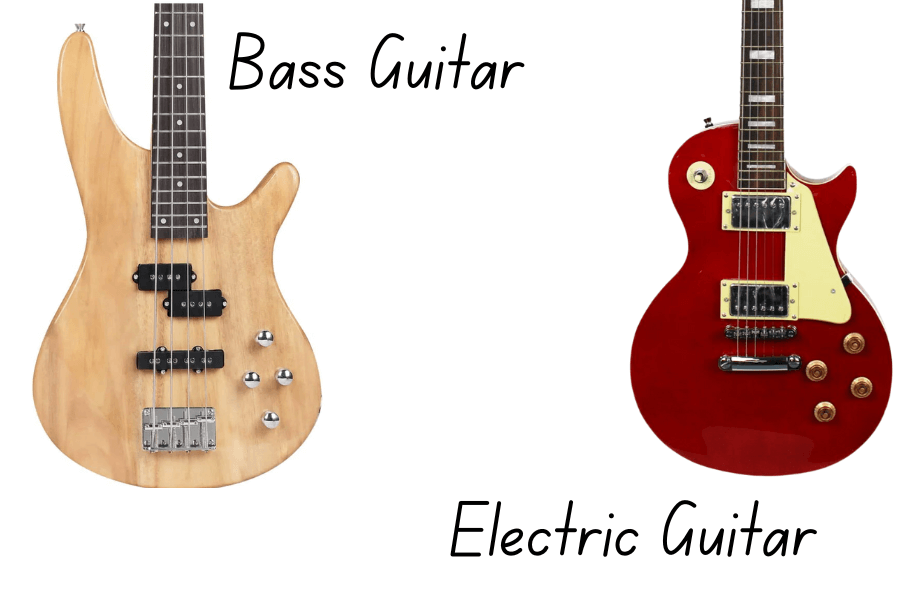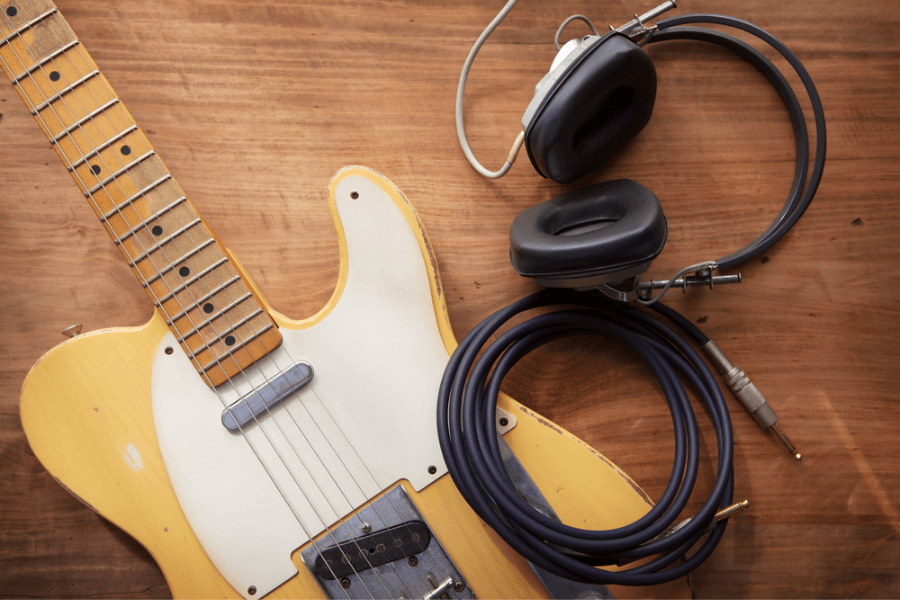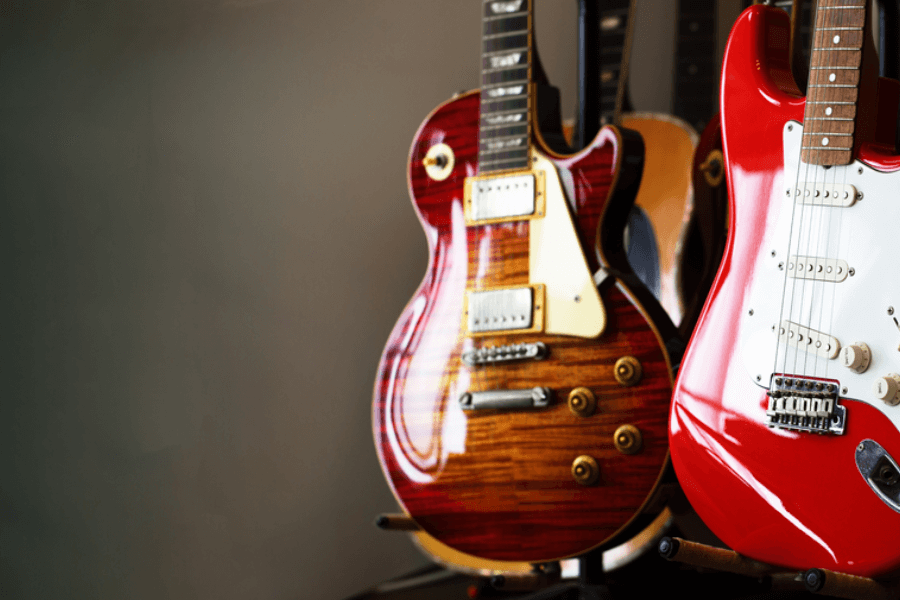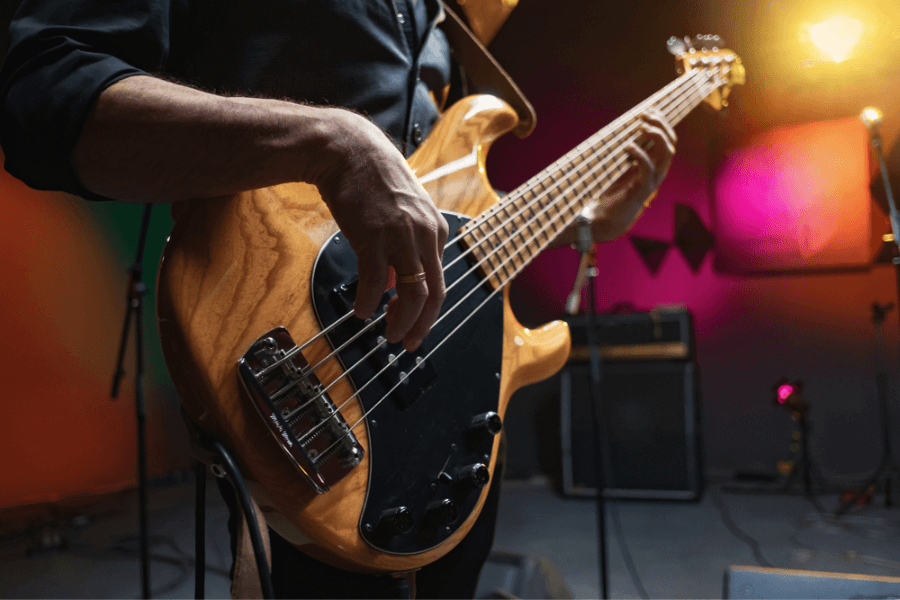For someone who doesn’t know much about guitars or music an electric guitar and a bass guitar might look a lot alike. Even though guitar and bass have some things in common, they are also very different and have different roles in a band or piece of music. Music fans are often confused when they are asked how to tell the difference between a bass and an electric guitar.
In this article, Eguitarmania gives you a comprehensive understanding of the difference between bass and electric guitar. Based on our experience, we will provide recommendations on the suitable play style for each type and its pros and cons.
The Difference Between Bass And Electric Guitar
When you first start playing stringed instruments, the difference between a bass guitar and an electric guitar might not seem very important. But a closer look shows that they are very different in many ways that go beyond how they sound in music.

Visual differences
Understanding the visual distinctions between bass and electric guitars helps differentiate them and explains their musical responsibilities.
General Appearance
Bass Guitars: Bass guitars are the giants in the family of guitars, with a body size that’s visibly larger than that of electric guitars. This sturdiness is not just for show; it supports the instrument’s capability to produce those deep, resonate sounds that form the backbone of a song’s rhythm section. For example, the Fender Precision Bass, a popular model among bassists, boasts a full, rounded body designed to enhance its sonic depth.
Electric Guitars: Electric guitars, in contrast, feature a more compact and varied body shape, tailored to produce a range of sounds from sharp leads to rhythmic chords. The Gibson Les Paul, with its iconic single-cutaway design, offers a classic example of an electric guitar’s sleek appearance. Its body shape not only contributes to its aesthetic appeal but also affects the instrument’s sound and playability.
Strings
Bass Guitars: Usually, bass guitars come with four strings, but there are variants with five or even six strings for added range. The strings are much thicker, which is necessary for producing lower sounds. For instance, the standard tuning of a 4-string bass guitar is E1, A1, D2, G2, where the numbers indicate the octave in scientific pitch notation.
Electric Guitars: Standard electric guitars have six strings, but models with seven or more strings are available for those seeking extended range or heavier sounds. The strings are thinner compared to bass guitar strings, allowing for a wider array of playing techniques. A typical 6-string electric guitar is tuned to E2, A2, D3, G3, B3, E4, providing a higher pitch range.
Construction
Scale Length:
Longer scales are found on bass guitars. The usual length for most models is around 34 inches (86 cm). This length is very important for making the low sounds that bass lines have. Nowadays, they have a short-scale bass is 30” to make it easier for them to travel up and down the neck.
Electric guitars usually have shorter scale lengths. For example, a Fender Telecaster’s scale length is about 25.5 inches (64.8 cm), which makes it easy to bend strings and play chords.
Material:
Thicker woods, like ash or mahogany, are often used in bass guitars to help make the sound warmer. Ibanez’s SR Series, for example, has a body made of wood, which helps it sound rich and full.
The Fender Stratocaster is one example of an electric guitar that might use lighter woods like alder to get a brighter sound. Using these kinds of materials helps the Stratocaster make its famously clear and precise tones.
Non-Apparent Differences: How They Sound
The non-apparent differences between bass guitars and electric guitars, particularly in how they sound, underscore the unique roles these instruments play in music.
Bass Guitar: The Foundation of Rhythm and Groove
The bass guitar has low-end frequencies, typically ranging from about 41 Hz (E1, the lowest note on a standard 4-string bass) to approximately 350 Hz. This fills the gap between the rhythmic percussion and the harmonic content of other instruments. Here are some main characters of bass guitar:

Styles: Depending on how it’s played, a bass guitar can sound mellow and subdued or aggressive and growling.
- Low-End Emphasis: The bass guitar is known for its deep, resonant tones that emphasize the lower frequencies. Bass lines are often referred to as having a ‘rumbling’ sound. The bass acts as a foundation for the music.
- Pickup Configuration: Bass guitars often feature one or multiple pickups. The pickups are specifically designed to capture the low frequencies, which results in a warm and rounded tone.
The playing technique, including finger style, slap, and pick playing, further influences the instrument’s tone, from smooth and mellow to percussive and aggressive. .While the bass guitar mainly emphasizes the low frequencies, it still has a wide range of tones.
It doesn’t have to only be repetitive single-note bass lines. Skilled bassists can create a variety of tones by using a variety of playing techniques. Plucking closer to the bridge gives a brighter tone, and slapping and popping will add percussive elements, as two of many examples.
Electric Guitar: Melody and Harmony
The electric guitar, on the other hand, creates rhythm, harmony, and texture in music. Electric guitars can make a huge range of sounds, from warm, clean tones to sharp, distorted leads. This is because their frequency range goes from about 82 Hz (E2, the lowest note on a normal 6-string guitar) to over 1,000 Hz. Here are some main characters of the electric guitar:
- Sound: Electric guitars can go from clean and soft to distorted and aggressive, allowing them to be used in various music genres. You can use different amplifiers and effects pedals with electric guitars to get an even greater array of sounds.
- Diversity in playstyle: Electric guitars can play many genres, crafting intricate solos, rhythmic chords, and everything in between.
- Pickups: Electric guitars almost always feature either two or three pickups. These are either single-coil, P90 or humbucker pickups and come in various configurations.
Electric guitars can be played in different ways. The use of effects pedals, such as distortion, reverb, and delay, further expands the electric guitar’s sonic palette, allowing for the creation of unique soundscapes and textures. You can delicately fingerpick them through to strumming with lots of power. The sound reflects how they are played.
Unsurprisingly, bass guitars and electric guitars sound very different. That comes from the nature of their role in music—bass being low and deep, for example—but also from the pickups, amplifiers, and effects that are involved, which will contribute to their overall sound.
Role in Music
Bass and electric guitars have very different functions within a band or a piece of music. Depending on the genre, they also play very different parts.

As mentioned earlier, the bass guitar serves as the sort of rhythmic foundation of a band. Despite often being in the background, the bass guitar’s role in music cannot be overstated. Along with the drums, it makes up the rhythm section, and together they keep the band or rest of musicians tightly connected.
It takes on the roles of melody and harmony and is often center stage. Electric guitars can express a huge range of feelings, from anger in a rough rock solo to happiness in a bouncy beat part. It will have a much more prominent place within the music and usually capture the listeners’ attention.
In some genres, like reggae, funk, and jazz, the bass guitar takes on a more prominent role in driving the rhythmic pocket. This gives the other instruments the chance to build on the foundation the bass has created.
The electric guitar is a very different beast. Through its depth and groove, the bass guitar gives songs their structure. The electric guitar, on the other hand, brings out the rhythm, harmony, and texture. Together, they create a lively interaction that improves musical pieces, and each instrument is necessary on its own.
Which is Easier to Play?
When I first picked up the bass guitar, it was large, and the thick strings under my fingers struck me. I found the basic bass lines of popular songs easier to follow, which was encouraging. Playing single notes on those large frets felt more forgiving, and I could keep pace with some of my favorite tracks sooner than I expected.
However, the physical effort to press down those strings was something I had to get used to. My fingertips ached at the end of each practice session, but this discomfort lessened as I developed calluses and finger strength.

When I switched to the electric guitar, I noticed right away that I needed a lighter touch to play the smaller strings, which felt good on my fingers. The shorter neck made the guitar easier to play because it fit better in my hands. But the problem changed from being physical to being mechanical.
I had to work on my timing and agility as I learned to strum across multiple strings and make chord shapes. It wasn’t enough to just play the right note; you had to play several notes at once that sounded good together and get through more complicated beats.
Both journeys have their challenges, but they’re worth every moment of frustration for the joy and satisfaction they bring. Remember, the best choice is the one that aligns with your passion and musical ambitions.
Final Thought
We really hope that we have helped you understand the difference between an electric guitar and a bass guitar. To tell the difference between a bass and an electric guitar, you need to know how they look and sound, as well as the different parts they play in music. Now is the moment for you to develop your own harmony !









